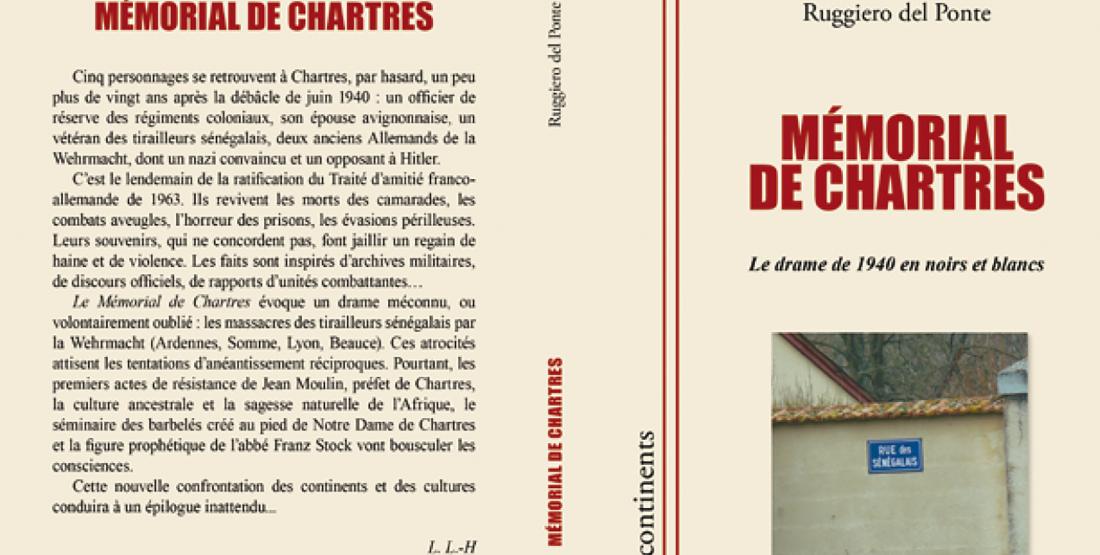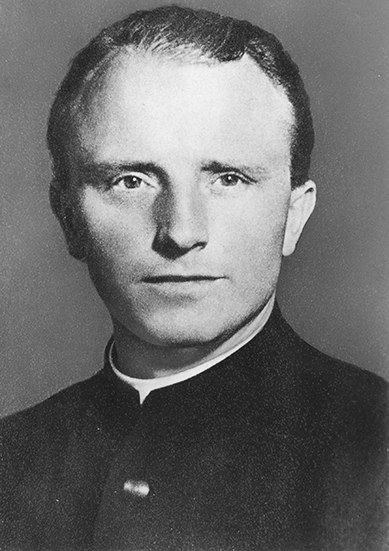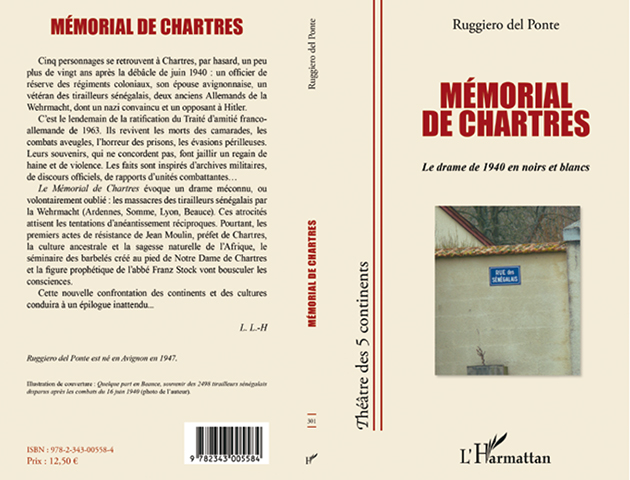Memorial to Chartres
Sous-titre
Interview with Gérard Valin

A member of the advisory board of the review Allemagne d’Aujourd’hui (Germany Today), Gérard Valin presents his play, Mémorial de Chartres : le drame de 1940 en noirs et blancs (Memorial to Chartres: the drama of 1940 in black and white). Divided into ten scenes and with a cast of five men and one woman, the play enacts a story based on military archives, official speeches and reports from combat units. Yet the events evoke a little-known episode of the Second World War.

Gérard Valin. © Rights reserved
What is the play about?
On 13 June 1963, near Chartres, four Second World War veterans met unexpectedly to celebrate the memory of Father Franz Stock, “the chaplain of Hell”. They met at the former military camp of Coudray-Morancez, where Stock had run the Séminaire des Barbelés, or “Barbed Wire Seminary”; hundreds of future German Catholic priests were held prisoner there between 1945 and 1947. That day, the ashes of Franz Stock – who had accompanied the Frenchmen condemned to death by the Nazis and executed by firing-squad at Mont Valérien – were transferred from Thiais cemetery to the church of Saint Jean-Baptiste de Rechèvres. Stock was head of the German Catholic mission during the Second World War, and had, at his own request, been appointed visitor to the prisons of La Santé, Fresnes and Cherche-Midi. Lieutenant Pierre and Sergeant Kao-Bao, of the 26th Regiment of Senegalese Tirailleurs (26th RTS), realised they were having coffee with their adversaries of 16 and 17 June 1940: Major Reutlingen and Oberfeldwebel Schmidt. The veterans set to talking about the bloody clashes of the 26th RTS with General Kurt Feldt’s 1st Cavalry Division (1. KD), a unit of Generaloberst von Kluge’s 4th Army. The fighting resulted in the death, internment in Frontstalags or “disappearance” of 600 members of this colonial regiment.
Why this choice of subject?
A dual coincidence. I came across the report by Lieutenant Pierre (2nd Battalion, 5th Company, commander of the 4th Section), telling of these clashes outside Chartres, in the family archives. I delivered it to the Fréjus colonial troops museum: it was the last missing report. The same year, the Association of Friends of Abbé Franz Stock asked me to be their Paris chair. I then made the connection between the experiences of Jean Moulin, prefect of Eure-et-Loir, and the fighting of the 26th RTS near Chartres. General Kurt Feldt demanded that Moulin acknowledge the colonial troops’ alleged crimes against civilian victims at La Taye. Moulin refused to lie (Premier combat : Journal posthume published by his sister Laure), was imprisoned with a member of the 26th RTS on the night of 17 June, and tried to commit suicide. Bénédicte Vergez-Chaignon relates this episode in his book Jean Moulin, l’affranchi. General Feldt ordered the officers of these “black savages” to be shot. The schwarze Schande, or “black shame”, has been documented by historians: Levisse-Touzé (editor, La campagne de 1940), Chapoutot (Des soldats noirs face au Reich - Les massacres racistes de 1940), Le Naour (La honte noire), Lormier (Comme des lions), Schek (Une saison noire - Les massacres des tirailleurs sénégalais, mai-juin 1940), Fargettas (Les tirailleurs sénégalais. Les soldats noirs entre légende et réalité 1939-1945). Jean-Jacques François’s excellent four-volume La guerre de 1939-40 en Eure-et-Loir deserves special mention.

Portrait of Franz Stock. © Association Les Amis de Franz Stock
The Wehrmacht propagated resentment in connection with the occupation of the Ruhr by colonial troops in 1923-25. German soldiers were subjected to intense Nazi propaganda against black people. They were accompanied by Goebbels’ propaganda companies.The tirailleurs and their officers were fearful, and rightly so, of the fate that awaited them after the fighting ordered by General Gransard (10th Army Corps), General Gillier (8th Colonial Light Infantry Division) and Colonel Perretier (26th RTS). They carried on the fight on the Cher and the Loire, and by 25 June their number had been reduced to one fifth. At noon on 17 June, however, Marshal Pétain, successor to Paul Reynaud, announced the end of the fighting, in agreement with his war minister, Maxime Weygand. The same day, de Gaulle arrived in London and met Churchill. Lieutenant Pierre, who was taken prisoner with the survivors of his section on 18 June, less than a mile from La Taye, made a perilous escape with the aid of the Gérard family of Fontaine-les-Côteaux. Also on 18 June, Admiral Cadart set sail from Brest with 2 000 tonnes of Banque de France gold bound for Dakar, on the eve of the arrival of the German troops...
Who are the target audience?
People with an interest in the history of the Second World War will find it appeals to them. Young people are not very well informed about these dramatic events. I therefore wrote “scenes” that can be acted out with no stage experience. Theatre groups can adapt the play for performance in schools to a range of age groups, from 11 to 18.
I am grateful to the Chartres members of the Franz Stock association, who organise visits to the Coudray-Morancez camp for schoolchildren from across Europe, beginning with Germany and France. The frescoes painted by Franz Stock on the site that served as a chapel have been restored by the associations of Chartres, Neheim (diocese of Paderbon) and Paris, thus making Stock’s reconciliation efforts, near Chartres cathedral, accessible to all.
The countries of origin of the tirailleurs included French West Africa and French Equatorial Africa. A vibrant tribute is paid to those who fought in the Battle of France, and that testament to their bravery is today addressed to their families, their descendants and their countries. I would be delighted if one day this play were included in the programme of the Festival Off Avignon; Avignon is my home town and an important centre for cultural exchange.

Cover of Mémorial de Chartres : le drame de 1940 en noirs et blancs. © Éditions L’Harmattan
What are the intentions and aims of this play?
I set out to explore the difficult pathways of reconciliation between countries and people who fought against one another. Mutual forgiveness cannot occur if we allow the events experienced by either side to be forgotten. That is expressed so magnificently in Franz Stock’s farewell speech, when the “Barbed Wire Seminar” closed in 1947. General de Gaulle adopted that message of hope in 1962 at Ludwigsburg, before signing the Élysée Treaty of Franco-German friendship with Chancellor Adenauer in January 1963. The play illustrates a difficult but necessary process, with the four soldiers of 1940 embodying a range of attitudes of reciprocal forgiveness, with its successes and failures. The end of the play suggests that hesitations, doubts and refusals line this arduous journey. The efforts to overcome the antagonisms require courage, generosity and reciprocal lucidity. This reconciliation between enemy brothers should, in my opinion, be considered as a model that tends to be neglected, at a time of exacerbated tensions and hegemonic desires around the world.
These gestures of fraternity were taken up by Edmond Michelet, Nuncio Roncalli, future Pope John XXIII, and Robert Schuman, to cite just three prominent figures of the wartime generation. New actors of peace are forever emerging around the world; let us hope they will be listened to in time to take up the challenges of the present.
Do you hope to see this play performed across the Rhine?
I leave that up to the theatre professionals. Laurent Contamin, former chair of the French playwrights’ association, the EAT, and a well-known author on both sides of the Rhine, helped me to formalise the project. Thanks to him, the play had been read by familiar actors of the Odéon, the “theatre of Europe”. I am relying on the Franz Stock friends’ associations to attract interested audiences in both countries.
I would go further and say I would happily translate the play into German, with the agreement of my publisher, L’Harmattan. But for now my priority is to finish an essay on the famous writer Thomas Mann, a Nobel Prize winner and great reconciler of contemporary cultures.

